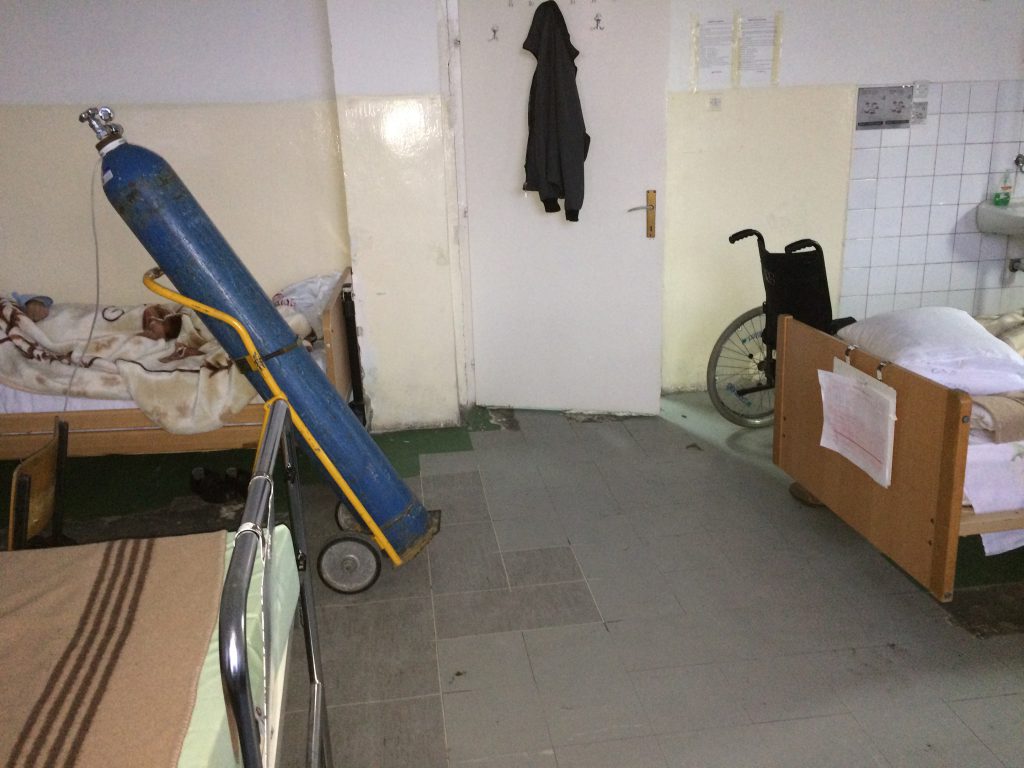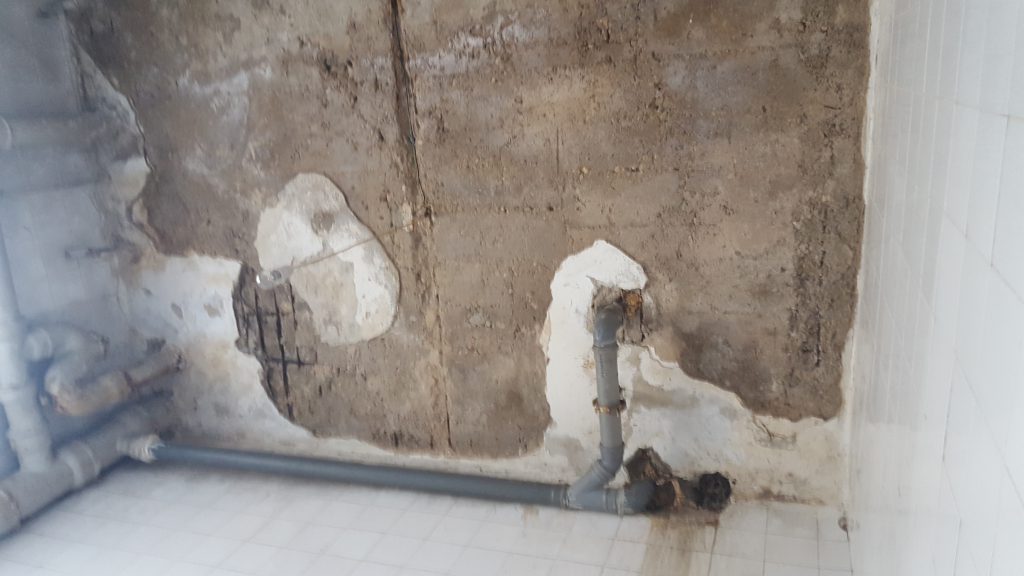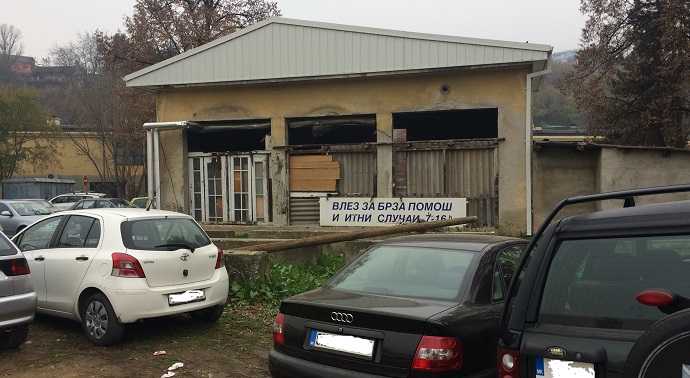April. For many it’s the best time of year, when people wake from a cold and long winter. For others, such as nurse Hava Sait Nexhip, it means the beginning of an annual, months-long water shortage at the medical campus outside Skopje where she has worked for eight years.
“Each April till September we don’t have water,” Sait Nexhip says, though she can offer no explanation. “But this year we didn’t have water beginning in March. We get water from the village tap just for hygiene purposes. We only use it for washing dishes and hands. So we manage somehow,” says Sait Nexhip, who is concerned for her and patients’ health. Among those patients is the mayor of Aracinovo, the local municipality, to whom they have repeatedly appealed for help with the water shortage, only to be told it’s not a municipality issue. They have also appealed unsuccessfully to the town’s main clinic. These days the company next door has arranged to pipe some of its water to the facility after media coverage of the issue, as a short-term fix.
“Deadly” Reforms

Macedonia’s health system should be undergoing a renaissance, with a slew of new investments and reforms, including My Term, which allows patients to schedule appointments, and Pay Upon Performance, which pays doctors according to how many exams and procedures they perform. Instead in the past few years the health system has been blamed for unnecessary deaths, including that of Tamara Dimovska, a child born with a twist in the spine who also suffered from bronchitis. She died while waiting for the Health Ministry to clear bureaucratic procedures to send her abroad for an operation it had agreed to fund. Or the spike in the number of infant deaths in hospitals, which hit 261 in 2016. Or the recent deaths of two patients stranded on the roadside in a broken-down ambulance.
All of which have left people in Macedonia wondering about the soundness of the country’s health care system. To help answer that question, we set off on a review of conditions in Macedonia’s hospital.
Most of the general hospitals throughout the country were built in the 1970s, but some, including the one in Kocani, eastern Macedonia, opened almost a century ago. Officials at some of the hospitals we contacted said nothing has been updated inside since they were built. Others have received partial renovations, some of which were funded by foreign aid. And still others, such as the general hospital in the western town of Struga, have used their own funds for refurbishments.
From 2006 to 2016, the Struga hospital spent more than 150,000 euros of its own money to upgrade its surgery, gynecology, internal medicine, and pediatric diseases departments as well as its laboratories and X-ray facilities, according to a statement from the hospital.
Also in the west, the Kicevo general hospital has renewed its gynecology and obstetrics department thanks to a foreign donation. Its newest equipment came from the Health Ministry eight years ago.
In the neighboring Gostivar municipality, officials say the hospital has received no recent upgrades, which seems clear from the crumbling façade and walls, broken electrical sockets, patched-up chairs in the waiting rooms, and worn-out floors. But most impressive is a visit to the toilets. One stall’s window is blocked by cardboard, while the broken tap in a yellowed sink cannot be shut off.
A member of the medical staff complains to us on condition of anonymity. For example, the source points out, patients receive bottled oxygen because the hospital has no centralized oxygen delivery system, which should be standard. “We even carry oxygen bottles into the surgery theaters. As for the hygiene in this hospital, you can see for yourself.
“The patients come healthier and leave sicker,” he says.
The clinical hospital in Shtip, in the east, has renovated its gynecology and obstetrics department, thanks to funds from UNICEF. But the shower stall in the maternity wing’s bathroom lacks a curtain, the toilets are old — one lacks a seat — and used paper towels are strewn about. The air is stagnant and the door to one stall hits the toilet so it cannot be fully opened, which represents a particular challenge to the pregnant women who come to the department.
Upstairs, a hole peeks from the shower stall, and water comes from yellowed pipes along aged walls.
Modern Facade, Old Equipment
Still, some hospitals are being updated. The general hospital in Veles is freshly painted on the outside, but inside patients still find old chairs and sticky toilets. Patients in the internal medicine department sit on a simple, old chair, not fit for purpose, to get a bath. Some of its equipment is 17 years old and has not been updated in a decade.
Urologist Dimitar Strovjanoski said his department received donated equipment in 2000 that is no longer usable. “In other countries that pay attention to proper hospital conditions, the equipment is replaced every three to five years. Here, the last update of this equipment was in 2009–2010,” Strovjanoski said.
He said doctors in his department compiled a list of needs four years ago but none has been met. As a result, he said, patients with complicated urological conditions must travel out of town for treatment. That includes those who need biopsies — a procedure he was trained in more than two years ago but still lacks the necessary equipment to perform.
Using the department’s old devices can be dangerous. For instance, a machine that uses electrodes in treating men with enlarged prostates has faulty wiring, putting patients and doctors at risk.
“There are electric arcs that are dangerous to whoever is working with it, so if there’s even a tiny hole in our rubber gloves, catastrophic consequences can occur,” he said.
Strovjanoski has been a physician for 30 years and a specialist for 25. Asked about the reforms the Health Ministry has been rolling out for years, he says, “I can’t say I’ve felt those reforms because they don’t address the needs of the patients for new equipment and proper treatment. For example, in our hospital, as far as I know, new equipment has been bought for the internal medicine department, while our urology department as well as orthopedics don’t have the proper equipment for patients in this region.”
In his hospital, he says, patients have rudimentary conditions. It would be nice, for instance, if rooms in the urology wing had their own bathrooms, given the nature of those patients’ ailments. “But the most important need for the patients is equipment that would contribute to quicker diagnostics and better outcomes,” he says.
(Un)successful Projects
Strovjanoski’s patients could go to Skopje, 50 kilometers away, but conditions at the state-run clinic there seem less than salubrious.
In the gynecology clinic, opened in 2011, the door on the ground-floor toilet, which needs a good cleaning, does not lock. Soap is nowhere to be found. In the pediatrics clinic, part of the ceiling hangs low.
The government health and sanitary inspectorate did not respond to detailed questions about these conditions but said its 30 inspectors were not enough to keep a close eye on health care facilities as well as other institutions, including schools and kindergartens.
“Nothing is better. It’s worse than ever,” said Menche Tochi, an award-winning journalist from НОВATV who has been covering the health system for decades. “There aren’t even pajamas for the patients who are hospitalized. Ten, 20, 30 years ago there were. Just for comparison, the patients a decade or two decades ago didn’t have to buy their own drugs. Now they’re forced to because often there’s little or no medicine in the hospital pharmacies,” she said, adding that the list of drugs covered by national insurance has not changed in at least a decade.
Tochi acknowledged that the government has bought some new, expensive equipment, but she said outcomes have not improved.
“If we consider better conditions that the new equipment has made possible, it didn’t solve the problem by itself,” she said. “It’s good that we have new equipment but it’s bad that the patients are waiting for months just to be screened. With some of this equipment, the staff hasn’t been trained, while other pieces have broken down, and since it costs a lot to repair them, they stay that way.”
She dismissed reforms as “marketing,” to be forgotten when the political campaign ends.
“For example, the My Term project might have been planned to bring order to the scheduling of patients’ exams, but it’s turned doctors into administrators, and now they can’t pay enough attention to their patients. … The Pay Upon Performance project isn’t even mentioned anymore.
“There’s a whole set of issues, including conditions in the hospitals, where there are old and ruined beds and cockroaches in the closets,” Tochi said. “I’ve covered these problems for more than 20 years now. I know how it works, and I’m not a big optimist that we’ll have a better health system anytime soon.”
Public Health Hits Bottom
Irena Mulachka, of the Fokus weekly, won a prize for a 2016 investigation into the deaths of 80 infants in six months at the Skopje gynecology and obstetrics clinic. Staff there blamed the deaths on hospital-contracted infections.
Throughout Macedonia, infant deaths in hospitals hit a five-year high in 2016.
Mulachka said despite a public relations campaign by Health Minister Nikola Todorov that touts Macedonia’s as one of the best health care systems in Europe, “the picture on the ground is different.”
“Instead of conditions improving over the years, I can say that the public health system has hit bottom: ruined doors and beds, broken windows, bloody and dirty sheets that smell, cockroaches, unsterilized instruments, …” she said, continuing with a litany of issues that she said make it more dangerous to be treated in a hospital than at home.
She said patients die waiting for the ambulance or because doctors lack basic supplies, including IVs and surgical thread. A few years ago, she said, a patient in Shtip nearly died from a burst ulcer for the lack of a probe that costs 15 denars.

Most alarming, Mulachka said, is the rising mortality rates among infants. She said doctors at a Skopje clinic have told her that a baby dies there every third day, primarily due to infections contracted in the hospital.
In 2016, “more than 200 babies have died, and a few patients have also died during botched operations,” she said. “What’s more frightening is that the number increases each day and the medical authorities keep quiet, as if this is normal. The strangest thing is that the gynecology building is brand new, with new medical equipment, but instead of infant mortality decreasing, it’s increasing.”
She said major issues have surfaced since the launch of the My Term program.
“Some of the patients complain that weeks pass before they can schedule a basic exam and it takes four or five months to schedule specialized treatments. Doctors in this program have only 15 minutes to examine a patient while the rest of their time is spent on administration. Therefore, it’s not strange that we have increased mortality and patients dying like lab rats from a badly structured health system,” Mulachka said.





